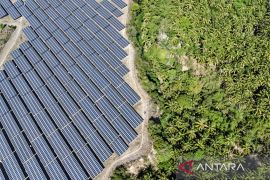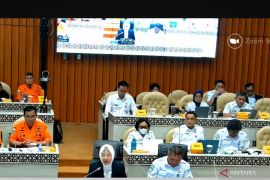Harvest failures were already reported in a number of areas such as Lebak in Banten and haze from forest and bush fires caused breathing difficulty in Riau and Jambi Provinces.Jakarta (ANTARA News) - The weather phenomenon El Nino has started to take toll in some parts of Indonesia.
Harvest failures were already reported in a number of areas such as Lebak in Banten and haze from forest and bush fires caused breathing difficulty in Riau and Jambi Provinces.
The worst is yet to come in October this year, the authorities said.
"Strong El Nino could cause lengthy drought, harvest failure, forest and bush fires and outbreak of dengue, although it could also cause good fish harvest in certain areas," head of the Meteorology and Geophysics office Andi Eka Sakya said in a meeting headed by the coordinating Minister for Maritime Affairs Indroyono Soesilo here on July 28.
Worrisome warnings have been issued by US, Japanese and Australian meteorology or weather forecasting agencies as well Indonesian Meteorology and Geophysics office.
President Joko Widodo (Jokowi) has also expressed concern with the unseen climatic monster to food security.
The president called a special meeting of related cabinet ministers to address the problem.
"We must take the threat seriously," the president said at the limited cabinet meeting attended by Vice President Jusuf Kalla, senior cabinet ministers, the national military chief Gen.Gatot Nurmantyo and police chief Gen. Badrodin Haiti.
Jokowi said El Nino is getting stronger between August and December causing drought in wide areas.
"Drought already hits Java, Sulawesi, Lampung, Bali, East Nusa Tenggara beginning in May," he said.
The president asked his ministers to find way to avert worse impact of El Nino or mitigate the damage.
"This afternoon we are discussing and trying to find a way out especially to deal with the hot spots and potential forest and bush fires," he said.
He said the government has to protect the livelihood of farmers, fishermen.
The National Disaster Control Agency (BNPB) recorded drought has hit at least 102 regencies all over the country.
BNPB spokesman BNPB Sutopo Purwo Nugroho said those areas had a deficit of 20 billion cubic meters of water.
"Currently drought has hit 102 regencies in 16 provinces all over Indonesia," Sutopo said.
The 16 provinces include Banten, West Java, Central Java, Yogyakarta, East Java, Bengkulu, Papua, East Nusa Tenggara, West Nusa Tenggara, South Sumatra, South Sulawesi, Lampung, Riau, South Kalimantan, Central Kalimantan and Bali.
"The hardest hit are Central Java, West Java, East Java, Lampung, South Sumatra and Bali," he added.
Extreme dry season has also dam, aged crops over at least 111,000 hectares of farmlands and the impact is feared to hit wider areas, he said.
In fact the country already suffered the impact of drought for over a decade, he said.
"A study by the National Development Planning Board (Bappenas) in 2003 said every year, 92 regencies in Java suffer a deficit in water supply for a week up to 8 months," he said.
Attempts to cope with the drought
The agriculture ministry hopes to complete construction of 1,000 water reservoirs and cultivate 2.6 million hectares of rain fed rice fields with second crops.
The Public Works Ministry said five of 16 major dams have been short of water, therefore, the ministry would use 760 water pumps for irrigation.
The five dams include Keuliling in Aceh, Batutegi in Lampung, Saguling in West Java, Wonogiri in Central Java and Bening in East Java.
Meanwhile, the Forestry and Environment Ministry is optimizing the use of water canons and retardant chemicals to extinguish forest and bush fires.
Director General of Water Resources Mudjiadi said the government through the Public Works and Housing Ministry has taken steps to forestall worse impact of drought in various areas brought about by the weather phenomenon this year.
He said water pumps have been made available for irrigation in areas where surface water has stopped flowing.
He said efficiency would be improved in the use of water. Dam water would be prioritized for household consumption, irrigation and industry.
"Fort the time being we stop using dam water for other purposes," he said.
Agriculture Minister Amran Sulaiman said the damaged to rice fields inflicted by drought this year was less extensive than last year.
In the period of October, 2013 to July 2014 drought caused 159,000 hectares of rice field without water as against only 57,000 hectares in the period of October 2014- July 2015.
"That means we succeeded in saving 102,000 hectares of rice field from the threat of drought," Amran said.
The minister said the government has made available Rp100 billion to build water reservoirs anticipating extreme dry season.
The reservoirs would be built in areas where lengthy drought is more endemic, he said, adding there are around 200,000 hectares of farm lands prone to drought and 25,000 hectares of then often face crop failure.
He said the government has set aside Rp880 billion to cope with El Nino inflicted damage this year.
The ministry has also asked governors, regents, city majors to use fund for special allocation of Rp2 trillion from the state budget to build water reservoirs.
"We have expected the drought since early January and we have taken preparatory steps such as by building and improving irrigation systems and other infrastructure, distributing water and other farming tools," the minister said.
Therefore, the government is confident that food security could remain safe, he said.
Meanwhile, the state owned Board of Logistic has held 2.5 million tons of rice in stock, a provision against scarcity in supply.(*)
Reporter: Ahmad Wijaya
Editor: Heru Purwanto
Copyright © ANTARA 2015











